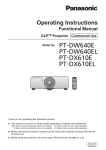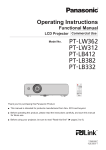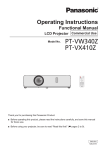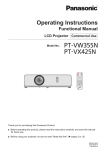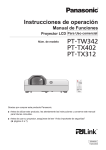Download "user manual"
Transcript
Operating Instructions Presenter Light Software Presenter Light Software Windows Thank you for purchasing this Panasonic product. Before using this software, please read the instructions carefully. TQBH0381 (E) Contents Introduction Software Licensing Agreement...........................................................................3 Request Regarding Security................................................................................4 Using the Software................................................................................................5 Preparations Check your computer...........................................................................................7 Checking the projector.........................................................................................9 Using the projectors with a wireless LAN connection....................................10 Using the projectors with a wired LAN connection......................................... 11 Obtaining the software.......................................................................................12 Operations of Functions Starting the software..........................................................................................13 Connecting projector directly and starting projection....................................14 Connecting after searching projectors and start projection..........................16 Stopping projection/Restarting projection.......................................................18 Setting the capture size......................................................................................19 Setting the options..............................................................................................20 Managing the projector which is connecting...................................................21 Disconnecting projector connection.................................................................25 Appendices Network Glossary................................................................................................26 Frequently Asked Questions.............................................................................27 Trademarks..........................................................................................................30 2 Introduction Software Licensing Agreement Use of this Software is governed by the terms defined in this “Software Licensing Agreement”. ffArticle 1 License The users obtain the license of the software (i.e. the information recorded or contained in CD-ROM, operating instructions or others), but the copyright or intellectual property right of the software does not transfer to the users. ffArticle 2 Use by a Third Party Licensee may not transfer or allow any third party, to use or copy the Software, whether free of charge or not. ffArticle 3 Restrictions on Copying the Software Licensee may make a single copy of the Software in whole or in part solely for backup purposes. ffArticle 4 Computer Licensee may install and use the Software on more than one computer owned or managed by Licensee. ffArticle 5 Reverse Engineering, Decompiling or Disassembly Licensee may not reverse engineer, decompile or disassemble the Software. Panasonic shall not be bound by warranty for any defects in the Software caused by Licensee’s reverse engineering, decompiling or disassembly of the Software. Furthermore, Panasonic or its distributors or dealers will not be responsible for any damage to the Licensee caused by Licensee’s reverse engineering, decompiling or disassembly of the Software. ffArticle 6 After-sales Service If you have a problem with the software, please contact the customer support center by telephone. Panasonic shall undertake to notify Licensee of whether the problem is a known error in the program (“bug”), or whether the way in which the Software is to be used should be modified. Furthermore, the Software is subject to revision without prior notice. ffArticle 7 Indemnification Panasonic’s liability with respect to this Software is limited to the conditions defined in Article 6 herein. Panasonic or any of its distributors or dealers shall not be liable for any damage suffered by Licensee, either directly or through claims from a third party, arising from or in connection with Licensee’s use of the Software. Furthermore, Panasonic Corporation does not guarantee the successful operation of the software unless it is used with any of Panasonic projectors. ffArticle 8 Export Control Licensee agrees not to export or re-export the Software to any county other than the country of purchase of the projector in any form without the appropriate export licenses under the regulations of the country where Licensee resides or of any other country as may be required by such export or re-export. rrSoftware information regarding this product This product incorporates the following software. (1) The software which is developed independently by or for Panasonic Corporation (2) The software owned by third party and licensed to Panasonic Corporation (3) The software which is licensed under the GNU GENERAL PUBLIC LICENSE Version2.0 (GPL V2.0) (4) The software which is licensed under the GNU LESSER GENERAL PUBLIC LICENSE Version2.1 (LGPL V2.1) (5) Open source software which is not licensed under the GPL V2.0 and LGPL V2.1 The software categorized as (3) ~ (5), the license is available in accordance with gnu general public license and gnu lesser general public license respectively, it is distributed in the hope that it will be useful, but without any warranty, without even the implied warranty of merchantability or fitness for a particular purpose. As for the terms and conditions, please refer to the software license of the supplied CD-ROM. If you wish to ask any questions as to the software, please contact ([email protected]) by email. Presenter Light uses the following software programs. A portion of this software is based in part on the work of the Independent JPEG Group. Please note the following. ff Panasonic Corporation hereby disclaims all liability for any damages or losses, whether suffered directly or indirectly, which have been caused by the use of or by trouble occurring in the projector. ff Panasonic cannot be held liable for damages arising from data corruption or loss as a result of using this projector. ff The illustrations and screen displays given in this manual may differ from what is actually displayed. ff In this manual, the operations are described basically on the Windows 8 screen. ff The specifications of this software are subject to change without notice. 3 Request Regarding Security When using this product, security breaches of the type described below are conceivable. ff Leakage of your private information via this product ff Illegal operation of this product by a malicious third-party ff Harm to or cessation of operation of this product by a malicious third-party Take steps to ensure that the projector and computer used are secured and protected. ff Make sure the password is as hard to guess as possible. ff Change the password periodically. ff Panasonic Corporation and its affiliated companies never directly ask customers for their password. ff Do not give out your password even if directly asked by a third-party representing themselves as Panasonic Corporation. ff Use the product in a network that is kept secure by firewall and other settings. ff Establish a password for the computer that will be used in order to restrict the users who can log on. Security-related precautions to be followed when using wireless LAN products The advantage of a wireless LAN is that information can be exchanged between a computer or other such equipment and an access point using radio waves as long as you are within range for radio transmissions. On the other hand, because the radio waves can travel through obstacles (such as walls) and are available everywhere within a given range, problems of the type listed below may occur if security-related settings are not made. ff Intercept communication content A malicious third-party may intentionally intercept and monitor transmitted data. - personal information such as your ID, password, and/or credit card numbers - content of e-mail ff Improper invasion A malicious third-party may access your personal or corporate network without authorization and engage in the following types of behavior. - Retrieve personal and/or secret information (information leak) - Spread false information by impersonating a particular person (spoofing) - Overwrite intercepted communications and issue false data (tampering) - Spread harmful software such as a computer virus and crash your data and/or system (system crash) Since most wireless LAN adapters or access points are equipped with security features to take care of these problems, you can reduce the possibility of these problems occurring when using this product by making the appropriate security settings for the wireless LAN device. Some wireless LAN devices may not be set for security immediately after purchase. To decrease the possibility of occurrence of security problems, before using any wireless LAN devices, be absolutely sure to make all security-related settings according to the instructions given in the operation manuals supplied with them. Depending on the specifications of the wireless LAN, a malicious third-party may be able to break security settings by special means. If you cannot perform security settings for your wireless LAN by yourself, please contact the Panasonic Support Center. Panasonic asks customers to thoroughly understand the risk of using this product without making security settings, and recommends that the customer make security settings at their own discretion and responsibility. Attention ff Wireless LAN connection function of the projector uses radio waves in the 2.4 GHz band. ff For the details about the wireless LAN connection and the information such as the usage channel of wireless LAN, please refer to the Operating Instructions of the projector. 4 Using the Software Using this software, the displays appearing on the computer screen can easily be projected by using a projector. ff When using the wireless LAN, the wireless module (Model No. ET-WML100) corresponding to this software is required. The basic steps to start projecting are described below. rrPreparations 1 Turn on the power of the projector. 2 Connect to the network through a LAN cable (when using the wired LAN). Insert the wireless module (Model No. : ET-WML100) into the projector (when using the wireless LAN). ff For more information about the projector which is compatible with the wireless module, please visit the following web site. http://panasonic.net/avc/projector/products/optional_accessories/ 3 Press the <MEMORY VIEWER/USB DISPLAY/NETWORK> button on the remote control to switch to network input. ff Press the <INPUT/ENTER> button on the control panel and the input source screen is displayed, then press as to select [Network]. 4 Check the login password and IP address of the projector which are displayed in the idle screen. z "Checking the projector" (page 9) 5 Check the SSID in the [Expand]→ [Network] screen (when using the wireless LAN). z "Using the projectors with a wireless LAN connection" (page 10) 6 Select the same SSID with the projector on the computer network connection screen and connect to the wireless LAN (when using the wireless LAN). z "Using the projectors with a wireless LAN connection" (page 10) 7 Access the compatible projector by the web browser, download the software and then save it on the computer. z "Obtaining the software" (page 12) rrStarting the Software 8 Start the software. z "Starting the software" (page 13) rrProjection 9 Enter the IP address and the login password on the confirmation screen to connect to the projector, and then start projection. z "Connecting projector directly and starting projection" (page 14) OR Search the projectors which can be connected by IP address or model No., select the target projector, enter the login password on the confirmation screen to connect to the projector, and then start projection. ff The computer screen will be projected from the projector. z "Connecting after searching projectors and start projection" (page 16) Memo ff This software and the USB Display function cannot be used at the same time. Before using this software, disconnect the USB cable to terminate the USB Display function. 5 Using the Software (cont.) rrPossible with this product <Multi style> The screen location can be switched among seven modes (Screen location: full screen, left side, right side, upper left, upper right, lower left, lower right). It is also possible to display up to four computer presentations simultaneously. <WEB control> It is possible to control the projector using the computer’s web browser. 6 Preparations Check your computer rrNecessary environment for computers to be connected ff First, check your computer to see whether or not it has a wired LAN or a built-in wireless LAN function. ff Before connecting the projector to the computer, be sure to check the following settings. ff Operation is not guaranteed for all wireless LAN adapters and built-in wireless LAN adapters. rrWireless LAN Check 1 Wireless LAN settings ff Is your wireless LAN adapter properly recognized? ff Is the wireless LAN adapter switched on? ff Install the wireless LAN adapter driver beforehand. For details on how to install the driver, refer to the instructions accompanying the wireless LAN adapter. Check 2 Computer’s settings ff When security (firewall) software and utilities for wireless LAN adapter are installed, these may prevent connection of the projector. ff Has the firewall for blocking unsolicited programs been turned off or shut down? z "Frequently Asked Questions" (page 28) rrWired LAN Check 1 For wired LAN ff Is the cable properly connected? ff The specifications for cables vary depending on the system configurations. Confirm the projector settings and the cable specification. Check 2 Wired LAN settings ff Is your wired LAN adapter properly recognized? ff Is your wired LAN adapter switched on? ff Install the wired LAN adapter driver beforehand. For details on how to install the driver, refer to the instructions accompanying the wired LAN adapter. Check 3 Computer’s settings ff When security (firewall) software is installed, it may prevent connection of the projector. ff Has the firewall for blocking unsolicited programs been turned off or shut down? z "Frequently Asked Questions" (page 28) 7 Check your computer (cont.) rrInstalling the software To use this software, the computer must satisfy the following requirements. OS: Microsoft Windows Vista 32 bit Microsoft Windows 7 32/64 bit Microsoft Windows 8 32/64 bit Microsoft Windows 8.1 32/64 bit WEB browser Internet Explorer 7.0/8.0/9.0/10.0/11.0 CPU: Intel Core 2 Duo 2.0 GHz or higher processor or compatible processor installed Intel Core i5 or higher recommended for projection Memory: 2 GB or more Hard disk: At least 20 MB free space LAN environment: For connection with a wired LAN: LAN connector (10BASE-T or 100BASE-TX) required For connection with a wireless LAN: Wireless LAN adapter (IEEE802.11b/g/n standard compliance) required Desktop area: 640 dots × 480 dots or more 1 600 dots × 1 200 dots or less Memo ff Note that operation is not guaranteed when used with system environments other than the above or on homemade computers. ff It may not be possible to use some of the functions of a computer if it is using a wireless WAN (wireless wide area network). ff When connecting under the IEEE802.11n standard, the wireless LAN adapter, projector and access point used must all support the 11n standard. ff If the computer has a switchable graphics function and the function is to be switched, remember to stop projection before switching the function. Operation is not guaranteed for all computers that meet the above conditions. 8 Checking the projector Memo ff The illustrations and screens in this document may differ from the actual ones. rrPowering up the projector Turn on the power of the projector. rrInstalling the wireless module Insert the wireless module (Model No.: ET-WML100) into the <USB A (VIEWER/WIRELESS)> terminal of the projector when connecting via wireless LAN. ff Please use the projector which is compatible with the wireless module. ff For more information about those projectors which are compatible with this product, please visit the following web site. http://panasonic.net/avc/projector/products/optional_accessories/ rrSetting the input 1 Press the <MEMORY VIEWER/USB DISPLAY/NETWORK> button on the remote control to switch to network input. ff The idle screen is displayed in the projected image of the projector. ff The login password (a four-digit number that is automatically generated), projector name : PROJECTOR (fixed), IP address (Wireless LAN) and IP address (Wired LAN) will be displayed in the idle screen. ff Press the <INPUT/ENTER> button on the control panel and the input source screen is displayed, then press as to select [Network]. Network input idle screen ● LOGIN PASSWORD ● PROJECTOR NAME ● IP ADDRESS (WIRELESS LAN) ● IP ADDRESS (WIRED LAN) LOGIN PASSWORD : PROJECTOR NAME : IP ADDRESS(WIRELESS) : IP ADDRESS(WIRED) : 5678 PROJECTOR 172.28.120.1 192.168.1.100 rrChecking the projector Check the login password and IP address (Wireless LAN / Wired LAN) of the projector. rrChecking the network information The network setting information can be checked in the projector menu. ff Press the <MENU> button of the projector and check the network information from the [Expand] menu → [Network] → [Network information]. ff [SSID] and [Wireless IP] will be displayed when using the wireless LAN and inserting the wireless module to the projector. ff When using the wireless LAN, in addition to checking the above mentioned items in "Checking the projector", please check SSID in [Network information]. Projector menu display 9 Using the projectors with a wireless LAN connection Connect the projectors and computer using a wireless LAN. ff Only one projector can be connected with a computer via the wireless LAN. rrChecking the setting information while attaching the wireless module 1 Insert the wireless module (Model No. : ET-WML100) into the projector. 2 Check [SSID] in [Expand] → [Network] when the menu screen is displayed. 3 Switch the input to [Network] and check the login password and IP address in the idle screen. ff The settings of the wireless module are as follows: [SSID] [Channel] NetworkDisplay 1 [IP address] 172.28.120.1 [Subnet] 255.255.255.0 [Gateway] 0.0.0.0 [Access point Encryption] None rrComputer settings 4 Set the computer's network settings to match with the settings of the projector. ff Before setting the computer’s network settings, check them with the network administrator. 5 Connect to the network that has been set in the projector. on the task tray (bottom right of the Windows screen), then select the same name as [SSID] that has been set ff Click in the projector. ff For detail about the setting change of SSID, refer to "Web control function" in the operating instructions of the projector. Memo ff If the network cannot be found, please check the Operating Instructions of the wireless LAN adapter. 10 Using the projectors with a wired LAN connection Connect the projectors and computer using a wired LAN. ff Before proceeding, turn on the projector and verify the IP address. rrProjector settings 1 Select the network settings of the projector. On the menu screen, select [Expand] → [Network]. Set the network. (Select the [Network setting] page from the web connection screen, set [LAN settings].) DHCP Projector menu display Factory settings Off IP address 192.168.1.100 Subnet mask 255.255.255.0 Default gateway 192.168.1.1 rrComputer settings 2 Change the TCP/IP setting. Windows 8/Windows 8.1 Press [X] while holding down the [Windows logo] key on the keyboard, and select [Control Panel] → [Network and Internet] → [Network and Sharing Center] → [Change adapter settings]. Right-click the connection to be changed, and click [Properties]. Click the [Networking] tab. In “This connection uses the following items”, click [Internet Protocol Version 4 (TCP/IPv4)], and click [Properties]. Windows Vista/Windows 7 Click [Start] → [Control Panel] → [Network and Internet] → [Network and Sharing Center] → [Change adapter settings]. Right-click the connection to be changed, and click [Properties]. Click the [Networking] tab. In “This connection uses the following items”, click [Internet Protocol Version 4 (TCP/IPv4)], and click [Properties]. 3 Set the computer’s network in line with the projector settings. Click [Use the following IP address], and input the values in the “IP address,” “Subnet mask” and “Default gateway” boxes. ff Before setting the computer’s network settings, check them with the network administrator. When connecting to a projector whose network settings are the factory settings IP address 192.168.1.101 Subnet mask 255.255.255.0 Default gateway 192.168.1.1 Memo ff Before setting the computer’s network settings, check them with the network administrator. 11 Obtaining the software This software is provided in the firmware of some projectors of Panasonic. You can obtain it from web by accessing to the corresponding projector or from Panasonic website directly. rrObtaining from web by accessing to the corresponding projector ff Firstly, power on the projector and check the IP address, and then connect the computer to the projector via the wired LAN or the wireless LAN. 1 Activate the Web browser in the personal computer. 2 Enter the IP address set by the projector into the URL input field of the web browser. ff The [Network Display System] screen is displayed. 3 Click [Download]. ff The download screen of "Presenter Light" is displayed. 4 Click [Download]. ff The download confirmation screen of the executable file “Presenter Light.exe” is displayed. 5 Save "Presenter Light.exe" on the computer desktop. ff This software is used as the executable file format. You cannot install it in the computer. ff Execute this file when using the software. Please save this software in the convenient place or make a shortcut for convenient use. ff The following icon is displayed when the file is saved on the desktop. rrObtaining from Panasonic website 1 Download "Presenter Light.exe" and save it on the computer desktop or some where. Memo ff Download the latest versions of this software from the following website. (http://panasonic.biz/projector/support/application/index.html) ff Please delete the executable file when this software is not required. 12 Operations of Functions Starting the software To start the software and operate the main menu. 1 Start this software . ff Main menu is displayed. ff At the same time, the button is displayed on the task bar. rrDescription of each part of the main menu ff Button icons in black can be selected, and the gray icons cannot be selected. ff Place the cursor on the button to enlarge the icon and display the function guide. ff The selected button becomes as larger blue icon. 8 7 1 2 3 4 1) Projector search button Enter the IP address of the projector and connect to the target projector directly. Search all the accessible projectors or search with the keywords, such as the model No. or the IP address of the projector and then connect to the target projector. 2) Start / Stop button Start / Stop the projection of the computer image. This button becomes to [ ] during projection. 3) Image size setting button Set the computer image in full screen projection or partially capture projection. 4) Setting button Execute the setting of each option. 5 6 5) Projector management button Display and control the status of the connected projector. 6) Connection termination button Terminate all the connections. 7) Minimize button Minimize the main menu and move to the notification area of the task bar with the icon [ ]. If the icon on the notification area is double-clicked, the main menu will be returned to the original position. 8) Exit button Exit this software. 13 Connecting projector directly and starting projection You can select the projectors from the menu and then connect the computer to them. ff Firstly, power on the projector. The connection cannot be established when the projector is in standby status. rrConnect the projector directly through the designated IP address 1 Click the projector search button . ff Connect / Search screen is displayed. 1 2 1) [Connect] button Click this button to connect the projector. 2) [Search] button Click this button to search the projectors which can be accessed. (z page 16) 2 Enter the IP address in the connection column. 3 Click [Connect] button. ff The connection confirmation screen is displayed. ff When the IP address is designated, it is able to connect even though the projector and the computer are in different domain. 1 2 3 4 3) [Background] Check this item, the computer screen is not displayed and the projector image will not be changed. Without checking this item, the computer screen will be displayed according to the screen location setting. 4) [OK] / [Cancel] Select to confirm / cancel the settings. 1) [Password] Enter the password that is displayed in the idle screen of the target projector. 2) [Select Screen Location] Select the screen location among full screen display (All), 2 split screen (L/R) or 4 split screen (1/2/3/4). The selected screen location becomes green. The yellow screen location is already assigned to other computers, it also can be selected. After selecting, the origin computer screen is switched to the using computer screen. 14 Connecting projector directly and starting projection (cont.) 4 Enter the login password and set the screen location. 5 Click [OK] button. ff After the connection is established, the projection starts. ] changes to the stop button [ ] during projecting. ff The start button [ ff If the screen location has not been set in step 4, it will be set to full screen (All) automatically. Memo ff The screen location can be switched in the projector management menu. (z page 24) ff When multiple computers are connected and some screen locations are already occupied by the other computers, if you select the same area or select a different category between the 2 split-screen display and the 4 splitscreen display, the already occupied screen location will be changed to the background, because the priority is given to the new setting. ff When the computer is connected to multiple projectors, if one of the projectors is disconnected with external factors (e.g. disconnecting the LAN cable, removing the wireless module), all of the other connections will be canceled. 15 Connecting after searching projectors start(cont.) projection Connecting after searching projectors and start and projection Search for the projector which you want to connect by using the search function. rrSearch all the projectors that can be connected 1 When the search field is blank, click [Search] button. ff The timer gauge is displayed during searching procedure, and then the model No. and icon of the projector that can be connected are displayed in the [Search result] field. ff The projectors which are in the same domain as the computer can be searched. x rrSearch the projector that can be connected by using the keyword 1 Enter the keyword in the search field. ff The searching function can be achieved by using a keyword that is partially correspond with the character string. ff You can enter the part of the IP address or the projector model No. as a keyword. ff Since there are uppercase and lowercase letters distinction, please enter uppercase letters when entering the model no. of the projector. 2 Click [Search] button. 16 Connecting after searching projectors and start projection (cont.) ff The timer gauge is displayed during searching procedure, and then the model No. and the icon of the projector that can be connected are displayed in the [Search result] field. ff The projectors which are in the same domain as the computer can be searched. ff When the search result is one projector, the connection confirmation screen is displayed. Please click [OK] button to connect. rrDescriptions of the searching list The model No. of the projector and the icon are displayed in the search result. The different type of icons are as following. Icon Description This is the projector which can be accessed via wired LAN, and it is not connected to any other computers. (gray arrow) This is the projector which can be accessed via wired LAN, and it is connected to your computer or other computers. (red arrow) This is the projector which can be accessed via wireless LAN, and it is not connected to any other computers. (gray antenna) This is the projector which can be accessed via wireless LAN, and it is connected to your computer or other computers. (red antenna) rrSelect the projector which is to be accessed in the searching list and then connect it 1 Put a check in the target projector. ff The [Connect directly] button becomes available. ff If the projector that is already connected with the computer is unchecked, the connection will be canceled. 2 Click [Connect directly] button. ff The connection confirmation screen is displayed on which is displayed the IP address. 3 Enter the login password of the target projector, set the screen location and then click [OK] button. ff Connect the selected projector. ff When the connection is normally established, the arrow or antenna of the projector icon will be changed from gray color to red color. rrConnect all of projectors in the searching list 1 Put a check in [Select all]. ff All the projectors are selected when put a check in [Select all]. 2 Click [Connect directly] button. ff The connection confirmation screen is displayed on which is displayed the IP address of every projector. 3 Enter the login password of the target projector, set the screen location and then click [OK] button. ff Connect the selected projector, the next connection confirmation screen of the projector will be displayed. 4 Return the step 3. ff Up to 16 projectors can be connected with a computer in total with the wired LAN and the wireless LAN. If the number of the target projectors exceeds 16, the [Max Session Number is exceeded!] will be displayed. ff When the connection is normally established, the arrow or antenna of the projector icon will be changed from gray color to red color. ff When selecting the screen position of the second and subsequent, if the different screen position category (full screen/2-split screen/4-split screen) is selected, "Display mode is conflicted with others." will be displayed and the connection will fail. Memo ff When newly connecting your computer to the projector that is already connected to the other computer, press the <MEMORY VIEWER/USB DISPLAY/NETWORK> button on the remote control to display the network idle screen and find out the login password. In addition, press the <MENU> button twice to cancel the network idle screen. 17 Stopping projection/Restarting projection You can stop or restart the projection with this menu operation. The main menu at projecting rrStopping the projection 1 Click Stop button on the main menu. ff The projection screen will change to blue back, the sound will disappear and the button (Stop button) will change to . the Start button rrRestarting the projection 1 Click Start button on the main menu. ff The button (Start button) will change to the Stop button and the image and sound are transferred in real time. Memo ff At the time that the computer screen is projected, the resolution of the computer may be forcibly changed depending on the combination of computer and projector. ff The sound can be output from the projector that the full screen display is selected with setting the screen location. ff The image is converted to JPEG format during transferring. The image quality of JPEG can be changed in [Setting] → [Jpeg image setting]. 18 Setting the capture size The content that you want to pay attention to can be enlarged to display during projection by using the capture function. rrSetting the capture size 1 Click the screen size setting button ff The selection screen is displayed. . 2 Select [FullScreen] or [Alterable]. Item [FullScreen] [Alterable] Description Projects the entire computer image within the screen area of "Screen location" while preserving original ratio, using all of either horizontal or vertical panel pixels of "Screen location". Projects the partially captured image of the computer image within the screen area of "Screen location" while preserving original ratio, using all of either horizontal or vertical panel pixels of "Screen location". rrWhen setting [Alterable] 1 Select [Alterable]. ff The capture area is displayed in a frame on the computer screen. 2 Adjust the area that you want to display by using the mouse to drag eight blue dots that are displayed on the frame. ff Projects the captured area that is transferred to the projector within the screen area of "Screen location" while preserving original ratio, using all of either horizontal or vertical panel pixels of "Screen location". Memo ff The minimum size that can be captured is 16 × 16 pixel. 19 Setting the options You can change the display language of menu and the image quality of the transferred image. rrOption settings 1 Click setting button . ff The basic setting screen is displayed. rrDescription about each part of basic setting 1 2 3 4 5 6 7 4) [OK] Click [OK] to apply the new settings and return to the main menu. 5) [Apply] Click [Apply] to apply the new settings. 6) [Cancel] Click [Cancel] to cancel the new settings and return to the main menu. 7) [Default] Return to default settings, such as [Language select] is [English], [Jpeg image setting] is [Medium]. 1) [Language select] Select the display language [English] / [ 日本語 ] / [ 简 体中文 ] of the menu. 2) [Jpeg image setting] Set the image quality [High] / [Medium] / [Low] of the transferred Jpeg. 3) [Software Information] Display the version and publisher of this software. Memo ff The menu will be switched to the selected language instantly at selecting [Language select]. ff These settings will be maintained until this software is terminated. All the settings will be returned to the default settings, such as [Language select] is [English], [Jpeg image setting] is [Medium]. ff When [Jpeg image setting] is set to [High], the speed at which the projected images are displayed may be slower since priority is given to the picture quality. 20 Managing the projector which is connecting You can get more information of the screen location from the searching list, and adjust or change the settings of the projector. rrCheck the screen location of the projector in the searching list 1 Click the connected projector icon. ff The IP address and the screen location icon of the computer are displayed in the field[Status on :]. (: The projector IP address is displayed.) ff The [Access via webpage] button is available at the same time. IP address of the projector IP address of the computer rrThe connected projector under web control 1 Click the connected projector icon. ff The icon of the screen location in [Status on :] column and the IP address of the computer are displayed. 21 Managing the projector which is connecting (cont.) 2 Click [Access via webpage]. ff The web connection screen ([Network Display System] screen) of the projector is displayed. 3 Click [Login ] and enter the password in the [Password] column. ff The factory default setting of the user name is “admin” (fixed) and the password is “admin”. 4 Click [Login ]. ff The [System Status] page is displayed. (The display screen will differ according to the projector used.) 5 Execute the various settings and adjustments of the projector. ff For more details, please refer to the operating instructions of the projector. Memo ff If [Setting] → [Standby mode] of the projector is set to [Eco], the network function is not available when the projector is in standby status. ff When connected via wireless LAN, cut off the power of the projector under web control, the projector will enter into standby status, the power supply of the wireless module will be cut off and the connection of this software will be cut off. Please note that the new connection is unavailable when the projector is in standby status. 22 Managing the projector which is connecting (cont.) You can change the setting of the screen location from the projector management screen, and adjust or change the settings of the projector. rrDisplay the connection status of projector 1 Click the projector management button . ff The information of the accessible projector is displayed. Icon Description The model number or the IP address of the projector is displayed on the right of the projector icon. The connection is established and the image/sound can be transferred. (only display) The connection is failed and the image/sound cannot be transferred. (only display) This software may be blocked with the Windows firewall.→ "FAQ" (z page 28) The sound can be output from the projector, when the selected screen location is [ ]. (only display) The sound cannot be output from the projector, when the selected screen location is except for [ (only display) ]. The setting status of the screen location. (The icon varies according to the selected screen location.) Click this icon to change the settings. Click this icon to cut off each connection. Click this icon to control the projector via web. Please refer to "The connected projector under web control" (z page 21). 23 Managing the projector which is connecting (cont.) rrSwitching the screen location Click the screen location icon [ ] (The icon varies depending on the selection status) of the projector that you want to connect in the [Projector Management] list, then select whether to display the computer screen in any screen location. 1 Click the screen location icon [ list. ] of the target projector in the [Projector Management] ff The "Select Screen Location" screen is displayed. ff The icon of the selected screen location of the using computer is displayed in yellow color and the unselected screen location is displayed in blue color in the selection filed. ff The gray part of the icons means the background area. Selected screen location ff The icons in the selection field are as followings. Category Unselected icon Selected icon Description Background The full screen changes to the background (B: Background), the computer image will not be displayed. It will display the image that is projected before using this software. One screen The computer screen is projected while preserving original ratio, using all of either horizontal or vertical panel pixels. (with audio) (the factory default) 2 split screen Projects the computer image that is displayed on the left side or the right side while preserving original ratio, using all of either horizontal or vertical panel pixels of the area. 4 split screen Projects the computer image that is displayed on upper left, upper right, lower left or lower right while preserving original ratio, using all of either horizontal or vertical panel pixels of the area. 2 Select the screen location. ff The icon that is on the right side of [Change Screen Location] is switched. (The icon is displayed in blue.) ff When multiple computers are connected and some screen locations are already occupied by the other computers, if you select the same area or select a different category between the 2 split-screen display and the 4 split-screen display, the already occupied screen location will be changed to the background, because the priority is given to the new setting. 3 Click [OK]. ff The screen location is switched. ff Please note that the screen location that has been occupied by the other computer will be forcibly switched. rrThe connected projector under web control You can change or adjust the settings of the target projector. 1 Click the icon [ ] of the target projector in the [Device management] list. ff The web connection screen ( [Network Display System] screen) of the projector is displayed. ff Please refer to "The connected projector under web control" (z page 21). 24 Disconnecting projector connection You can disconnect the projector or terminate the software. rrDisconnecting single connection 1 Click the projector management button . ff The information about all accessible projectors is displayed. 2 Click the icon [ ] of the relevant projector that you want to disconnect in the list. ff The confirmation screen of the connected termination is displayed. 3 Click [OK] button. ff Disconnect the selected projector connection. rrDisconnecting all connections 1 Click the connection terminating button in the main menu. ff The confirmation screen of the connected termination is displayed. 2 Click [OK] button. ff Disconnect all connections. rrDisconnecting all connections and terminating the software 1 Click the icon [ ] in the main menu. ff The confirmation screen of termination is displayed. 2 Click [OK] button. ff Disconnect all connections and terminate the software. 25 Appendices Network Glossary Word Explanation Access point This is a device which serves as a transmitter and receiver of radio signals when a computer and network are connected using a wireless LAN. When a computer is connected to an access point, it can communicate through the network connected to the access point. AES Abbreviation for “Advanced Encryption Standard”. The standard prevents the decryption of the encryption keys by continually changing the keys even during communication for greater security. Since the hardware performs the encryption processing, the access point must also support AES. Next generation standard cryptography standardized by the National Institute of Standards and Technology (NIST). Default Gateway The devices that are used for different network standards from yours. Default Gateway enables a connection with other network, by adjusting bilateral differences such as communication protocols. If no gateway is specified for the IP address of access destination, data will be sent to the host set as the default gateway. DHCP Abbreviation for “Dynamic Host Configuration Protocol”. This function automatically assigns IP addresses to the connected equipment. If a device with the DHCP server function is present within a LAN, it automatically assigns IP addresses to the connected equipment. Encryption This refers to converting data into a form which is not understandable to other people. Decisions are made in advance on the rules (algorithms) and keys (network keys) for converting the data between the sender and receiver, and the data converted (encrypted) by the sender is restored to its original form (decrypted) by the receiver. Important exchanges can be made without their being read by other parties. Firewall This is a security system designed to protect computers from unauthorized access via a network (such as the internet). Unauthorized access is prevented by restricting the data exchanged between the network and computer, and allowing only authorized data to pass through to the computer. Hub This device brings together cables of the same type in order to relay information. USB hubs and network hubs are examples. IP address Internet Protocol (IP) is a protocol for distributing data, and the address corresponding to the data distribution destination is called the IP address. The same IP address cannot be used within the same LAN. LAN Abbreviation for “Local Area Network”. This is a network with a relatively narrow range such as inside a company. Logoff This action clears the status (logon) in which it is possible to access a network or computer system. It is also called ‘logout’. Logon This action establishes the status in which a network or computer system can be accessed. It is also called ‘login’. MAC address This is the intrinsic ID number that is allocated to each network adapter. Every network adapter in the world is given its own number, and it is based on this number that data is sent and received between adapters. This address is expressed by combining an intrinsic number controlled and allocated by IEEE to each manufacturer with a number which the manufacturer allocates to each of its adapters. Protocol This is a common convention or rule required for data communication between computers. In order to enable data exchanges between different computers, it is necessary to have at both ends the same convention or rule governing such aspects as the timing at which the data is sent and received, and the format used for information which is to be sent and received. For instance, many different kinds of software communicate data over the internet using a protocol called TCP/IP (Transmission Control Protocol/Internet Protocol). SSID Abbreviation for “Service Set ID”. The SSID identification code must be set to distinguish equipment included in a wireless LAN that uses access points from equipment not included in that LAN. This may appear as the “ESSID” or the “network name” for wireless LAN adapters made by some manufacturers. Subnet mask This limits the range of the IP addresses assigned to computers in order to divide the network into a number of sections during TCP/IP connection. The value used to divide the network at this time is called the subnet mask. Wireless LAN This is a network which uses signals to communicate wirelessly. It obviates the need for a LAN cable connection since the data is sent and received using a common wireless frequency. SSID or WEP can be used to ensure that the transfer of information remains secure. WPA-PSK WPA2-PSK This is a standard covering encryption methods used in wireless LAN. It provides greater security than WEP (Wired Equivalent Privacy), and has functions such as a user authentication function and also TKIP (encryption protocol) which automatically changes the encryption key at fixed intervals. And this authentication requires no authentication server. 26 Frequently Asked Questions rr No wireless connection can be made between my projector and my computer. ff Has the software been started up? This software must be started in the computer in order to enable wireless transmissions of images to the projector. ff Have the correct network settings been established? Check whether the correct network settings have been established for the projector and for the computer. ff Have the projector been powered on? When the projector is in standby status, the wireless module is not supplied the power and the wireless connection is disabled. ff Have the wireless module been attached to the projector? rr When the “Cannot find LAN adapter” error is displayed. ff Is the wireless LAN adapter effective? If the wireless LAN adapter is disabled, enable it. For some PCs with an internal wireless LAN, the hardware switch or the software setting might have turned off the wireless LAN. If it is turned “OFF,” turn it “ON” before start this software. (In the case of a computer which also uses Bluetooth, Bluetooth may take priority so switch the priority to wireless LAN.) Refer to the operation manual of your PC for information about switching on/off. ff Is your wireless LAN adapter properly recognized on the network? Sometimes, wireless LAN adapters are not correctly recognized by the computer. Check in [Device Manager] whether the adapter is recognized correctly. If the Network Adapter is indicated with [?] in [Device Manager], wireless LAN adapter installation is not complete. See the User’s Manual of your wireless LAN adapter and re-install the driver. <To display [Device Manager]> Windows Vista Click [Start] → [Control Panel] → [System and Maintenance] → [System]. This will bring up [View basic information about your computer]. Click [Device Manager]. Windows 7 Click [Start] → [Control Panel] → [System and Security] → [System]. This will bring up [View basic information about your computer]. Click [Device Manager]. Windows 8/Windows 8.1 Press [X] while holding down the [Windows logo] key on the keyboard, and select [Control Panel] → [System and Security] → [System]. This will bring up [View basic information about your computer]. Click [Device Manager]. rr The wireless LAN connection is interrupted suddenly. ff The picture may be disappeared or frozen by the radio wave environment. In such cases, please try the following measures. –– Please make the wireless LAN connection device close to the projector that is attached to the wireless module. –– Place away from the devices that can emit electromagnetic radiation, such as microwave ovens, game machines. Do not use these devices if you are still unable to solve the problem. –– If multiple wireless devices are connected with the same router, the bandwidth will be insufficient. Please cut off the power supply of the devices that are unused, or do not use the other devices as much as possible. –– Please prevent from using the projector in a location prone to static electricity, such as on a carpet. rr The wireless LAN or the wired LAN connection is cut off. If projection has been suspended or communication has been cut off, select the projector again on the projector searching list. If it is still not possible to communicate with the projector, turn off the power of the projector, wait until the projector has cooled down, and then disconnect the power cable. Turn the power back on, and then select the projector again from the software. 27 Frequently Asked Questions (cont.) rr The connection cannot be established with IEEE802.11g / IEEE802.11n. ff In environments with wireless LAN adapters that support both IEEE802.11b and IEEE802.11g, the connection may be established via IEEE802.11b. ff In some operating environments, the connection may be established via IEEE802.11b, depending on the location, radio signal conditions, distance, or other factors. ] icon in the [Projector management] list, and the rr The status of the target projector is indicated with [ computer image cannot be projected ff This software has been licensed by Windows firewall. Take the following steps that correspond to the operating system used. Windows Vista Is this software registered on the [Exceptions] tab of [Allow a program through Windows Firewall]? Register this software in the Exceptions to Application List of the firewall. <How to register> 1. Click [Start] → [Control Panel]. 2. Click the [Security] tab when the <Control Panel> window opens. 3. Click [Allow a program through Windows Firewall]. 4. Click [Continue] in [User Account Control]. 5. Click the [Exceptions] tab and then [Add program...] when the <Windows Firewall Settings> window opens. 6. Click [Browse...] when the <Add program...> window opens. Select [Presenter Light.exe] that has been saved and click [OK]. 7. Confirm that this software has been added in the [Program or port] field. 8. Double-click [Presenter Light.exe], and open the <Edit a Program> window. 9. Click the [Change scope...] button at the lower left of the window. 10. W hen the <Change scope> window opens, select the desired network as described below. Select [Any computer (including those on the Internet)]. 11. Click [OK] 12. Click [OK] in the <Edit a Program> window. 13. Click [OK] in the <Windows Firewall> window. This software is registered as an application on the Windows firewall exception list. Windows 7 Is this software registered in [Allow a program through Windows Firewall]? <How to register> 1. Click [Start] → [Control Panel]. 2. Click [System and Security] when the <Control Panel> window opens. 3. Click [Allow a program through Windows Firewall] in the <System and Security> window. 4. Click the [Change settings] to change to the allow registration mode. 5. Click the [Allow another program], select [Presenter Light.exe], and click the [Add]. 6. Confirm that this software has been added to the [Allowed programs and features] list. Confirm that the Home/ Work (Private) and Public checkboxes are checked. 7. Click the [OK] button in the <Allow programs to communicate through Windows Firewall> window. This software is registered as an application on the Windows firewall exception list. Windows 8/Windows 8.1 Is this software registered in [All an app through Windows Firewall]? <How to register> 1. Press [X] while holding down the [Windows logo] key on the keyboard, and click [Control Panel]. 2. Click [System and Security] when the <Control Panel> window opens. 3. Click [All an app through Windows Firewall] in the <System and Security> window. 4. Click the [Change settings] to change to the allow registration mode. 5. Click the [Allow another app], select [Presenter Light.exe], and click the [Add]. 6. Confirm that this software has been added to the [Allowed programs and features] list. Confirm that the Private and Public checkboxes are checked. 7. Click the [OK] button in the <Allowed apps> window. This software is registered as an application on the Windows firewall exception list. rr Image display is slow or animation is not displayed smoothly. ff Is the computer CPU speed slow? Displaying images and playing animations depend to a large extent on the performance of the computer’s CPU. ff Adverse effects may be exerted if there is any wireless communication in the vicinity. ff The speed may be slower when any other applications are running concurrently. 28 Frequently Asked Questions (cont.) rr There is a time lag between operations at the computer and results in the projected image. ff This software reads the screen, compresses the data and transmits it to the projector. In the projector, the received data are extracted and then projected. Some delays occur in this system, due to the processing time and factors in the wireless environment. Different computers may also produce varying lag times. rr No sound of the computer is heard from the projector during projection. ff The sound of the computer can be output when the setting of the screen location is the full screen display. It is disabled when using the other modes of the screen location. rr The software’s colors are not displayed properly and the characters are hard to read. ff Set the screen colors to 16 bits or more. rr The button on the task bar disappears. ff If the main menu is minimized, it will be moved to the notification area of the task bar. rr This software cannot be started. ff When using the USB Display function, this software cannot be started. Please start this software after terminating the USB Display. rr When the “Network is unreachable.” error is displayed. ff Enter the correct IP address. 29 Trademarks ff Microsoft, Windows, Windows Vista and Windows Media are trademarks or registered trademarks of Microsoft Corporation in the United States and/or other countries. ff Intel, Intel logo and Intel Core are trademarks or registered trademarks of Intel Corporation or its subsidiaries in the United States and/or other countries. ff Other company names, product names or other names noted in this manual are trademarks or registered trademarks of the respective companies. Note that ® and TM marks are not indicated in the text of this manual. Notes: ff Unauthorized use or reproduction of part or all of this product software and manuals is strictly prohibited. ff Panasonic cannot be held liable for any effects resulting from the use of this product software and manuals. ff Panasonic reserves the right to revise this product software specifications and manual contents without notice. Panasonic Corporation Web Site : http://panasonic.net/avc/projector/ © Panasonic Corporation 2015 W0715HZ0 -ST






























